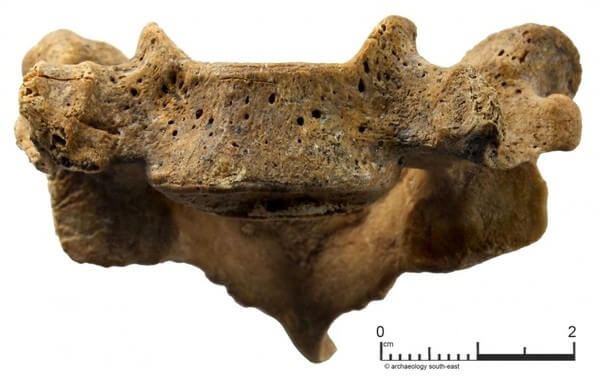Rampion uncovers ancient Anglo Saxon remains along onshore cable route
Archaeologists from Archaeology South East, UCL, working on behalf of the Rampion project, uncovered the well-preserved remains of the adult male aged 25 to 35 years in a well-cut grave in chalk bedrock on the south-western side of Truleigh Hill, north of Shoreham-by Sea.
The 1,000-year-old remains, thought to be an execution killing of around 1010-1025 AD, were found by archaeologists when surveying the route for the onshore cable which now carries power from the 400MW wind farm. The skeleton was recovered intact with the exception of missing a few small bones from the hands and feet. He was laid facing upwards with his arms at his side in an east west alignment, with no sign of a coffin.
The remains were excavated as part of the Rampion Offshore Wind Farm development alongside environmental consultants RSK in accordance with standard and professional techniques. The skeleton’s age was established by radiocarbon dating which indicated death before the Norman Conquest, during a time known as the late Anglo Saxon period. Further analysis revealed signs of a physically active life ending violently with cuts to the neck.
Jim Stevenson, Project Manager for Archaeology South East, said: “Specialist osteological assessment and radiocarbon dating has revealed that the skeleton is most likely to be an execution burial of the later Anglo Saxon period of around 1010-1025 AD. Most significantly two cut marks made by a sharp blade or knife were found at the mid length of the neck, which would have proved fatal for the individual.”
Chris Tomlinson, Development and Stakeholder Manager for the Rampion Offshore Wind Farm, said: “We have been very intrigued by this unexpected Saxon discovery and it’s been fascinating to learn so much from the radiocarbon dating research and analysis about this person and how they met their end.”
The isolated burial was found along the ancient route of the South Downs Way in an area of known prehistoric graves recorded in the West Sussex Historic Environment Record. It is believed some were once identifiable as visible surface burial mounds and were excavated in the 18th and 19th centuries and sometimes coincide with isolated burials.
“Throughout consultation and construction, we have continued to work closely with the South Downs National Park Authority and West Sussex County Council to make sure all onshore activity is carried out in a responsible way,” added Chris Tomlinson.
Elizabeth Gent, Project Manager for the South Downs National Park Authority, said: “We are working very closely with Rampion and their contractors to ensure that the scheme causes minimal impact in the protected landscape of the South Downs National Park, taking account of the rich cultural heritage and important habitats. We are pleased to see this partnership working and the excellent care being taken in dealing with such important archaeological finds.”

Rampion skeleton vertebrae showing cut marks to the neck
The late Anglo Saxon remains were uncovered in 2015 during the wind farm construction process.
A full report of archaeology uncovered during construction including a complete analysis of the burial remains and other relics found along the cable route is due to be published by Archaeology South East in 2019-2020.
An extensive archaeology programme was undertaken as part of the Rampion onshore cable route. This included:
- a watching brief, with strip, map and sample investigations,
- full excavations and
- geoarchaeological investigations.
Archaeological remains spanning millennia from the late Neolithic through to the Bronze Age, Roman, mediaeval and post-medieval periods were uncovered and include finds of flint tools, pottery, pits and salt-working and watercress cultivation features.
An archaeology evening is being hosted by Rampion at the Ropetackle Arts Centre in Shoreham on Tuesday 12 June at 7pm.
A number of archaeological finds uncovered during construction will be on display including the vertebrae from the Saxon skeleton showing cut marks, as well as a selection of prehistoric, Roman and medieval pottery and various flint tools.
The event is free to attend and speakers from the wind farm, environmental consultants RSK, Wessex Archaeology and Archaeology South-East will be present.
For more information visit rampionoffshore.com/news/news-events/public-archaeology-event-on-june-12/
- Source:
- E.ON
- Author:
- Press Office
- Link:
- www.eonenergy.com/...
- Keywords:
- E.ON, Rampion, offshore, onshore, cable work, archeology, human body, skeleton

























